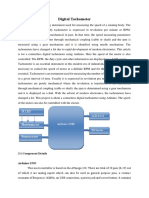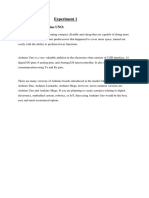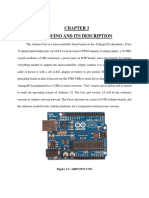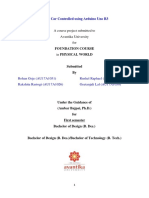0 ratings0% found this document useful (0 votes)
73 viewsComponents of Arduino Uno
The Arduino Uno is considered the archetypal Arduino board that most people start with. It contains an ATmega328P microcontroller chip as the "brain" of the board. The chip sits in a socket and is connected to pins around the edge of the board that allow input/output of electrical signals and power. These pins enable the Arduino Uno to interface with additional circuits and components via a breadboard. The Arduino bridges the gap between conventional computers and electronic circuits by translating signals and allowing circuits to be controlled by code.
Uploaded by
Alexiandria MaggayCopyright
© © All Rights Reserved
We take content rights seriously. If you suspect this is your content, claim it here.
Available Formats
Download as DOCX, PDF, TXT or read online on Scribd
0 ratings0% found this document useful (0 votes)
73 viewsComponents of Arduino Uno
The Arduino Uno is considered the archetypal Arduino board that most people start with. It contains an ATmega328P microcontroller chip as the "brain" of the board. The chip sits in a socket and is connected to pins around the edge of the board that allow input/output of electrical signals and power. These pins enable the Arduino Uno to interface with additional circuits and components via a breadboard. The Arduino bridges the gap between conventional computers and electronic circuits by translating signals and allowing circuits to be controlled by code.
Uploaded by
Alexiandria MaggayCopyright
© © All Rights Reserved
We take content rights seriously. If you suspect this is your content, claim it here.
Available Formats
Download as DOCX, PDF, TXT or read online on Scribd
You are on page 1/ 5
Since the Arduino is open source,
Getting to you might also purchase a board that
does not come directly from the
Know the Arduino organization.
You can think of the
Arduino Uno microcontroller chip itself as the
brains of the board. The chip
No one definitive Arduino board The Arduino Uno Board used in the Arduino Uno is the
exists; many types of Arduino ATmega328P, made by Atmel.
boards are available, each with its It is the large, black component
own design to suit various Uno is Italian for the number one, in the center of the board. This
applications. Deciding what board to named for the release of version 1.0
use can be a daunting prospect
chip is known as an integrated
of the Arduino software.
because the number of boards is circuit, or IC. It sits in a socket;
R3 relates to the revision of the if you were to remove it, it
increasing, each with new and
features on the board, which would look like the one shown
exciting prospects.
includes updates, refinements, and
However, one board can be in Figure 5.2 (Nussey, 2018).
fixes. In this case, it is the third
considered the arche- type of the revision
Arduino hardware, the one that
almost all people start with and that
is suitable for most applications. It is
Small Components of
the Arduino Uno (Nussey, 2018).
Arduino Header sockets
There are several versions of the
The Brains: ATmega328P The microcontroller socket connects
Arduino; it has been around since
microcontroller chip all the legs of the ATmega328
2005 and is constantly evolving.
microcontroller chip to other
sockets, referred to as header range of voltages (0v to 5v in the By bridging this gap, it is possible to
sockets, which are arranged around ATmega328P’s case) (Nussey, use a conventional computer’s
the edge of the board and are labeled 2018). benefits — ease of use, user-friendly
for ease of use. These black sockets interfaces, and code that is easy for
The Arduino (see the sketch in
are divided into three main groups: humans to understand — to control a
Figure 5.3) is special because it can
digital pins, analog input pins, and wide range of electronic circuits and
interpret these electric signals and
power pins (Nussey, 2018). even give them complex behaviors
convert them to digital signals that
with relative ease (Nussey, 2018).
All these pins transfer a voltage, your computer can understand —
which can be either sent as output or and vice versa. It also enables you to
received as an input. Why are these write a program using soft- ware on
pins important? They allow you to a conventional computer that the Digital Pins
connect additional circuitry to the Arduino IDE (integrated You use digital pins (refer to Figure
board quickly and easily when development environment) converts 5.3) to send and receive digital
prototyping with a breadboard and to or compiles to electrical signals that signals. Digital implies that the pins
design additional boards, called your circuit can understand (Nussey, have two states: off or on. In
shields, that fit neatly on top of your 2018). electrical terms, these states translate
Arduino board (Nussey, 2018). to a value of 0 or 5 volts, but no
This same process of sending and values in between (Nussey, 2018).
receiving electrical signals is going
on inside modern computers. But
Analog Pins
because they are so advanced and You use analog in pins (refer to
refined compared to a humble Figure 5.3) to receive an analog
Arduino, it is difficult to directly value. An analog value is taken from
link a computer accustomed to a range of values. In this case, the
digital signals (0s and 1s) to an An Arduino Uno with all the important range is the same 0V to 5V as with
electronic circuit that deals with a parts labeled. the digital pins, but the value can be
at any point — 0.1, 0.2, 0.3, and so external supply jack (for example, used on your home printer or
on (Nussey, 2018). 12V). You can also use this pin to scanner, so you may find a few
supply power to the Arduino from around the house that can serve as
What about Analog Out another source (Nussey, 2018). handy spares. The Arduino uses the
The shrewd ones among you may USB both for power and to transfer
GND marks the ground pins, which
have noticed that there seem to be no data. Using a USB cable is perfect
are essential to complete circuits.
analog out pins. In fact, the analog for low-power applications and
There is also a third ground by pin
out pins are there, but they are when data is being sent to or
13. All these pins are linked and
hidden among the digital pins received from a computer (Nussey,
share the same (called common)
marked as PWM using the ~ symbol. 2018).
ground (Nussey, 2018).
PWM stands for pulse-width
modulation, which is a technique You can use 5V or 3.3V to supply Power Socket
you can use to give the impression a 5-volt or 3.3-volt power supply, Next to the USB socket is another
of an analog output using digital respectively, to components or socket; this one is for power. This
pins. The ~ symbol appears next to circuits (Nussey, 2018). socket allows you to power your
digital pins 3, 5, 6, 9, 10, and 11, Arduino from an external power
USB Socket
showing that you have six pins that supply. The supply could be from an
are capable of PWM (Nussey, 2018). AC-to-DC adaptor (similar to those
used on other consumer electronics),
Power Pins a battery, or even a solar panel
You use the power pins to distribute To tell the microcontroller on the (Nussey, 2018).
power to inputs and outputs Arduino board what to do, you need
The connector needed is a 2.1 mm
wherever power is needed. to send a program to it. On the Uno,
center positive plug. Center positive
you send programs primarily by a
Vin, which stands for voltage in, can simply means that the plug has an
USB connection. The large, metallic
be used to supply a voltage (V) outside and an inside that fit the
socket is a USB port for a USB A-B
equal to the one supplied by the socket and that the inside of the plug
cable. This cable is similar to the one
must be positive. You should be able not function correctly. Or if you » ON is green and signifies that your
to find this plug among the standard provide too much power, your board Arduino is powered.
connectors that come with most might overheat and potentially be » RX and TX tell you that data is
power supplies; otherwise, you can damaged (Nussey, 2018). being received or transmitted by the
buy the connector and attach it to board.
bare wires (Nussey, 2018).
If you connect a power supply that is
LEDs » L is a special LED connected to
digital pin 13. It is great for testing
the opposite (center negative), it is LEDs come in a variety of shapes to see whether your board is
known as having a reverse polarity.
and sizes and are found in almost functioning as you want.
Components on the Arduino Uno every modern piece of consumer
will resist your attempts to send If your Arduino is plugged in but
electronics, from bike lights to TVs you do not see any lights, double-
voltage the wrong way around the to washing machines. You see a lot
board, but those components can check that:
more of them in numerous
melt in the process of saving your » Your USB cable is plugged in
examples.
board, depending on how much
power you are sending and how long The components described in this » Your USB port is working — try
it takes you to notice the burning section are tiny. The Uno board has another device in the port
smell! If you reverse the polarity four LEDs (light-emitting diodes) » Your cable is working — try
when using the Vin, 5V, or 3.3V labeled L, RX, TX, and ON. An another cable, if possible
pins, you bypass this protection and LED is a component that produces
light when electrical current flows If the LED still doesn’t illuminate,
almost instantly destroy several parts
through it (Nussey, 2018). something is probably wrong with
of your board and the ATmega328P
your Arduino. Your first destination
chip (Nussey, 2018). These four LEDs are used to should be the Arduino
The recommended voltage for the indicate activity on the board, as troubleshooting page at
Uno board is 7–12V. If you supply follows: http://arduino.cc/en/Guide/trouble
too little power, your board might shooting. If you still have no luck,
request a replacement Arduino from
where you purchased the device.
Reset Button
The Uno board also has a button
next to the USB socket called the
reset button. It resets the program on
the Arduino or stops it completely
when held down for a time.
Connecting a wire between GND
and the reset pin, which is located
next to the 3.3V, achieves the same
results.
The board has many other
components, all of which perform
important jobs, but the ones
described in this section are the key
ones for you to know for now.
You might also like
- David Amos, Dan Bader, Joanna Jablonski, Fletcher Heisler Python100% (15)David Amos, Dan Bader, Joanna Jablonski, Fletcher Heisler Python643 pages
- Digital Tachometer: 3.1 Component DetailsNo ratings yetDigital Tachometer: 3.1 Component Details12 pages
- E Book Ultimate+Home+Automation+Using+Advance+AI+Assistant+JARVISNo ratings yetE Book Ultimate+Home+Automation+Using+Advance+AI+Assistant+JARVIS22 pages
- Temperature Monitoring by Microcontroller Using ArduinoNo ratings yetTemperature Monitoring by Microcontroller Using Arduino44 pages
- Arduino Basics & Programming For Beginners With Internet of Things Projects100% (8)Arduino Basics & Programming For Beginners With Internet of Things Projects243 pages
- Jhoanie Marie P. Cauan Bsece 4 - 1 CPEN 105B Engr. Andy A. DizonNo ratings yetJhoanie Marie P. Cauan Bsece 4 - 1 CPEN 105B Engr. Andy A. Dizon5 pages
- B4__Batch2020-24_MajorProject_ThesisReport_BabyMonitoring_MuneerUddin_May2024_rptNo ratings yetB4__Batch2020-24_MajorProject_ThesisReport_BabyMonitoring_MuneerUddin_May2024_rpt81 pages
- Fingerprint Starter Vehicle Using Arduino Ijariie17219No ratings yetFingerprint Starter Vehicle Using Arduino Ijariie172195 pages
- Root Locus Method For The Control SystemNo ratings yetRoot Locus Method For The Control System21 pages
- American International University of BangladeshNo ratings yetAmerican International University of Bangladesh9 pages
- University of Buea: College of Technology (Department of Mechanical Engineering) MET413: WorkshopNo ratings yetUniversity of Buea: College of Technology (Department of Mechanical Engineering) MET413: Workshop25 pages
- Experiment 1: Introduction To Arduino UNONo ratings yetExperiment 1: Introduction To Arduino UNO6 pages
- 3.1 Basics of Hardware Design and Functions of Basic Passive ComponentsNo ratings yet3.1 Basics of Hardware Design and Functions of Basic Passive Components31 pages
- Arduino "Getting Started" Tutorial: HardwareNo ratings yetArduino "Getting Started" Tutorial: Hardware7 pages
- Arduino "Getting Started" Tutorial: HardwareNo ratings yetArduino "Getting Started" Tutorial: Hardware7 pages
- Lab Manual - RA3CO35 - Embedded SystemsNo ratings yetLab Manual - RA3CO35 - Embedded Systems24 pages
- Parallel programming: concepts and practice González-Domínguez - The full ebook set is available with all chapters for download100% (1)Parallel programming: concepts and practice González-Domínguez - The full ebook set is available with all chapters for download51 pages
- Advanced ATM Security System by Using Smart Card and IOT TechnologyNo ratings yetAdvanced ATM Security System by Using Smart Card and IOT Technology69 pages
- Roughness Meter: Portable Surface Roughness Tester For Commutators & Slip RingsNo ratings yetRoughness Meter: Portable Surface Roughness Tester For Commutators & Slip Rings2 pages
- Systems Programming and Computer Control CT047-3.5-2 Individual AssignmentNo ratings yetSystems Programming and Computer Control CT047-3.5-2 Individual Assignment14 pages
- Be Electronics and Telecommunication Engineering Semester 5 2023 November Microcontrollers Pattern 2019No ratings yetBe Electronics and Telecommunication Engineering Semester 5 2023 November Microcontrollers Pattern 20192 pages
- Importance of Computer: ABAN, Kaye Nichole C. G12-39 Concept PaperNo ratings yetImportance of Computer: ABAN, Kaye Nichole C. G12-39 Concept Paper3 pages
- An Assembly Language Program Can Have Up To 5 Fields: 1.address Field 2.object Code Field 3.label Field 4.mnemonic FieldNo ratings yetAn Assembly Language Program Can Have Up To 5 Fields: 1.address Field 2.object Code Field 3.label Field 4.mnemonic Field50 pages

























































































